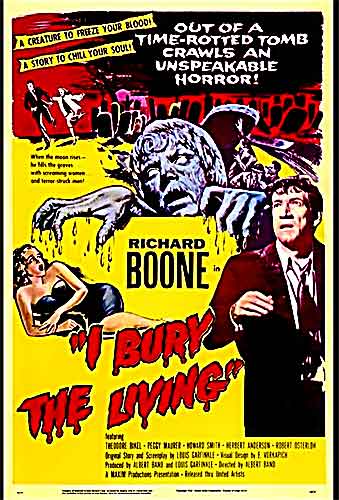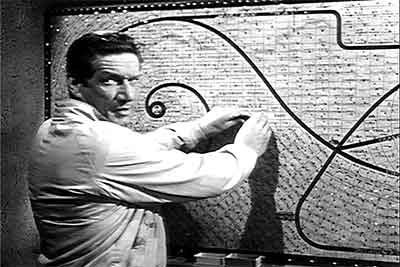 A fifties-era descent-into-madness tale of a man who comes to believe he can control who lives or dies based on the color pins he sticks in a cemetery map. An odd and disquieting little film with impressive visuals, though not without some glaring flaws.
A fifties-era descent-into-madness tale of a man who comes to believe he can control who lives or dies based on the color pins he sticks in a cemetery map. An odd and disquieting little film with impressive visuals, though not without some glaring flaws.
A fifties-era descent-into-madness tale of a man who comes to believe he can control who lives or dies based on the color pins he sticks in a cemetery map.
I BURY THE LIVING (1958) is precisely the type of little-known no-budget effort people are always “discovering” years after the fact. In this case, however, the film has long since been discovered (Stephen King chose it as one of the 20 scariest movies of all time) even though it remains pretty obscure. It was shot in nine days on location in an LA cemetery by the prolific B-movie auteur Albert Band (father of Charles) and released on the drive-in circuit with a lurid and extremely misleading title—in the course of the film nobody, after all, is buried, living or otherwise.
Stephen King chose it as one of the 20 scariest movies of all time.
Robert Kraft, a mild-mannered department store chairman, is pressed by his superiors into taking over the management of a cemetery as a half-assed act of civic responsibility. He’s taught the ropes by Andy, an Irish accented codger who shows Robert a large wall map denoting the cemetery’s grave plots. Pins with white heads are stuck in some of the plots, meaning the plot has been sold but the body isn’t yet interred. The remainder of the plots are occupied by pins with black heads, meaning they’re occupied by corpses.
One day a mistake is made: Robert sticks black pins where white ones are supposed to be, and the individuals listed, a healthy young couple, meet their deaths that same day. Intrigued, Robert deliberately transposes the pins in the plot of a wealthy toymaker, who promptly dies of a heart attack. It seems Robert can make people die simply by sticking a black pin into their place on his wall map.
 Robert’s superiors naturally pooh-pooh his claims, and turn down his repeated requests to quit his post. In fact, they unanimously agree to have Robert stick black pins in each of their plots. This he does, reluctantly—and two of the proscribed victims die later that night. The third, Robert’s uncle Charlie, shows up at the cemetery to retrieve Robert…who, in a supremely agitated state, refuses to leave. He later finds Uncle Charlie dead in his car.
Robert’s superiors naturally pooh-pooh his claims, and turn down his repeated requests to quit his post. In fact, they unanimously agree to have Robert stick black pins in each of their plots. This he does, reluctantly—and two of the proscribed victims die later that night. The third, Robert’s uncle Charlie, shows up at the cemetery to retrieve Robert…who, in a supremely agitated state, refuses to leave. He later finds Uncle Charlie dead in his car.
It was shot in nine days on location in an LA cemetery…
Increasingly losing his grip on reality, Robert has an inspiration: he’ll remove all the black pins from the map and substitute white ones–if he has the power of death, it makes sense that he must also have the power of life. He fails, however, to grasp the full significance of this “gift”, at least until the next morning, when Robert, wandering through the cemetery, finds the bodies missing from the grave sites he marked the night before…
I BURY THE LIVING may have been a no-budget production with a truncated shooting schedule, but it was made with a fair amount of care. The stark, contrasty black and white cinematography is excellent, particularly considering the scant budget, and production designer Edward Vorkapich contributes some memorably expressionistic sights (such as distorted numbers on a clock and a hallucinatory pan through a maze of giant black pins). The result is a powerfully ominous, disquieting evocation of psychological horror.
…made with a fair amount of care.
The narrative suffers somewhat from its relentlessly one-note premise. Even at a scant 77 minutes, it feels unnecessarily drawn-out and repetitive. Watching the protagonist stick pins in his map and then agonize over whether somebody’s going to die doesn’t exactly make for riveting viewing, especially when it happens again and again. There is a climactic twist, although it wasn’t exactly unexpected (at least to these jaded eyes). Even more annoying is a final surprise suggesting, ludicrously, that the proceedings have not been supernatural at all (complete with an obligatory police inquest to clarify things for slow viewers).
I still recommend I BURY THE LIVING, as a sterling example of old school horror at its most unique. But an “overlooked classic” it’s not.
Vital Statistics
I BURY THE LIVING
Maxim Productions/United Artists
Director: Albert Band
Producer: Albert Band, Louis Garfinkle
Screenplay: Albert Band, Louis Garfinkle
Cinematography: Frederick Gately
Editing: Frank Sullivan
Cast: Richard Boone, Theodore Bikel, Peggy Maurer, Herbert Anderson, Howard Smith, Robert Osterloh, Russ Bender, Glen Vernon, Lynette Bernay, Ken Drake, Cyril Delevanti
